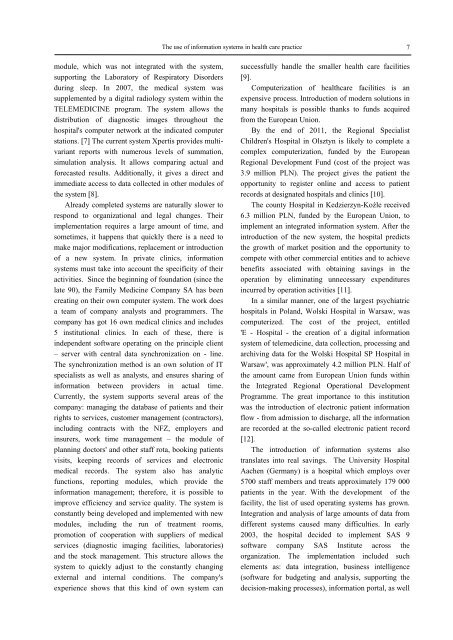Wsparcie spoÅeczne u chorych z miażdżycÄ tÄtnic koÅczyn dolnych
Wsparcie spoÅeczne u chorych z miażdżycÄ tÄtnic koÅczyn dolnych
Wsparcie spoÅeczne u chorych z miażdżycÄ tÄtnic koÅczyn dolnych
Create successful ePaper yourself
Turn your PDF publications into a flip-book with our unique Google optimized e-Paper software.
The use of information systems in health care practice 7<br />
module, which was not integrated with the system,<br />
supporting the Laboratory of Respiratory Disorders<br />
during sleep. In 2007, the medical system was<br />
supplemented by a digital radiology system within the<br />
TELEMEDICINE program. The system allows the<br />
distribution of diagnostic images throughout the<br />
hospital's computer network at the indicated computer<br />
stations. [7] The current system Xpertis provides multivariant<br />
reports with numerous levels of summation,<br />
simulation analysis. It allows comparing actual and<br />
forecasted results. Additionally, it gives a direct and<br />
immediate access to data collected in other modules of<br />
the system [8].<br />
Already completed systems are naturally slower to<br />
respond to organizational and legal changes. Their<br />
implementation requires a large amount of time, and<br />
sometimes, it happens that quickly there is a need to<br />
make major modifications, replacement or introduction<br />
of a new system. In private clinics, information<br />
systems must take into account the specificity of their<br />
activities. Since the beginning of foundation (since the<br />
late 90), the Family Medicine Company SA has been<br />
creating on their own computer system. The work does<br />
a team of company analysts and programmers. The<br />
company has got 16 own medical clinics and includes<br />
5 institutional clinics. In each of these, there is<br />
independent software operating on the principle client<br />
– server with central data synchronization on - line.<br />
The synchronization method is an own solution of IT<br />
specialists as well as analysts, and ensures sharing of<br />
information between providers in actual time.<br />
Currently, the system supports several areas of the<br />
company: managing the database of patients and their<br />
rights to services, customer management (contractors),<br />
including contracts with the NFZ, employers and<br />
insurers, work time management – the module of<br />
planning doctors' and other staff rota, booking patients<br />
visits, keeping records of services and electronic<br />
medical records. The system also has analytic<br />
functions, reporting modules, which provide the<br />
information management; therefore, it is possible to<br />
improve efficiency and service quality. The system is<br />
constantly being developed and implemented with new<br />
modules, including the run of treatment rooms,<br />
promotion of cooperation with suppliers of medical<br />
services (diagnostic imaging facilities, laboratories)<br />
and the stock management. This structure allows the<br />
system to quickly adjust to the constantly changing<br />
external and internal conditions. The company's<br />
experience shows that this kind of own system can<br />
successfully handle the smaller health care facilities<br />
[9].<br />
Computerization of healthcare facilities is an<br />
expensive process. Introduction of modern solutions in<br />
many hospitals is possible thanks to funds acquired<br />
from the European Union.<br />
By the end of 2011, the Regional Specialist<br />
Children's Hospital in Olsztyn is likely to complete a<br />
complex computerization, funded by the European<br />
Regional Development Fund (cost of the project was<br />
3.9 million PLN). The project gives the patient the<br />
opportunity to register online and access to patient<br />
records at designated hospitals and clinics [10].<br />
The county Hospital in Kedzierzyn-Koźle received<br />
6.3 million PLN, funded by the European Union, to<br />
implement an integrated information system. After the<br />
introduction of the new system, the hospital predicts<br />
the growth of market position and the opportunity to<br />
compete with other commercial entities and to achieve<br />
benefits associated with obtaining savings in the<br />
operation by eliminating unnecessary expenditures<br />
incurred by operation activities [11].<br />
In a similar manner, one of the largest psychiatric<br />
hospitals in Poland, Wolski Hospital in Warsaw, was<br />
computerized. The cost of the project, entitled<br />
'E - Hospital - the creation of a digital information<br />
system of telemedicine, data collection, processing and<br />
archiving data for the Wolski Hospital SP Hospital in<br />
Warsaw', was approximately 4.2 million PLN. Half of<br />
the amount came from European Union funds within<br />
the Integrated Regional Operational Development<br />
Programme. The great importance to this institution<br />
was the introduction of electronic patient information<br />
flow - from admission to discharge, all the information<br />
are recorded at the so-called electronic patient record<br />
[12].<br />
The introduction of information systems also<br />
translates into real savings. The University Hospital<br />
Aachen (Germany) is a hospital which employs over<br />
5700 staff members and treats approximately 179 000<br />
patients in the year. With the development of the<br />
facility, the list of used operating systems has grown.<br />
Integration and analysis of large amounts of data from<br />
different systems caused many difficulties. In early<br />
2003, the hospital decided to implement SAS 9<br />
software company SAS Institute across the<br />
organization. The implementation included such<br />
elements as: data integration, business intelligence<br />
(software for budgeting and analysis, supporting the<br />
decision-making processes), information portal, as well

















